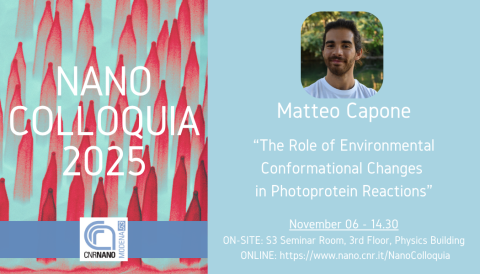
Photo-activated proteins are enzymes whose function is regulated by light absorption. Although only a few classes of light-activated proteins are known, their presence is widespread and their role is crucial for the functioning of Earth’s biosphere.
Understanding their mechanisms is fundamental, not only for advancing basic knowledge, but also for enabling a broad range of applications, from energy conversion to biomedicine. Within this framework, multi-scale computational modeling has proven to be a powerful tool for unveiling the mechanistic and structural features of these proteins [1]. In particular, hybrid quantum/classical methods as the Perturbed Matrix Method (PMM) [2] can capture the subtle effects of the protein environment, which can fine-tune the photochemical response and often determine functional outcomes. Our studies have explored both classes of photo-proteins: those in which light serves as a fuel for catalytic chemical reactions, and those where light acts as a switch for triggering other biological processes.
In the first group, Photosystem II (PSII) operates as the primary converter of sunlight into energy-rich molecules during photosynthesis, thereby shaping Earth’s atmospheric composition. This reaction is driven by a complex reaction center composed of multiple chromophores, generating oxidizing species with a reduction potential of up to 1.23 V, the highest known in living organisms. Such reactive states are formed upon light absorption and stabilized through spatial charge separation that prevents charge recombination.
Despite decades of research, the ultrafast nature of these processes and experimental limitations have left the precise mechanism of active species formation under debate. Using PMM, we explored several charge separation pathways through kinetic and redox calculations, providing a model that can be directly compared with experimental observations. This model reconciles previously conflicting interpretations and highlights the crucial role of protein-solvent dynamics in shaping ultrafast charge separation [3,4].
Conversely, rhodopsins belong to the second group of photo-proteins, acting as light-activated trans-membrane ion channels found across many species, from bacteria to animals. Here, light absorption triggers the isomerization of a retinal chromophore, initiating a photocycle that governs channel opening, ion flow, and eventual recovery of the dark state. Because their activation modulates electrical signaling, rhodopsins have been employed as photoswitches for neuronal activity control. Among these, Channelrhodopsin-2 (ChR2) is one of the most widely used tools in optogenetics. However, its performance is limited by the presence of a parasitic photocycle induced by continuous illumination, which reduces ion current and prolongs recovery times. The mechanistic origin of this side pathway has remained elusive. Through extended molecular dynamics simulations and multi-scale modeling, we show that different protein conformational basins promote distinct protonation states of a key residue, directing the system either along the canonical or the parasitic photocycle [4].
References [1] M. Capone et al. ACS Phys. Chem. Au 4 (3), 202-225. [2] L. Zanetti-Polzi et al., Phys. Chem. Chem. Phys., 2018. 20(37), 24369-24378. [3] M. Capone et al., Angew. Chem. Int. Ed., 2023, 135 (16), e202216276. [4] M. Capone et al., Nat. Commun. Under review. [5] L. Bellucci et al. Int. J. Bio. Macromol., 2025, 305140977.
This seminar is realized in the framework of the funded project
-PRIN2022 EnvELOP (project nr. 2022WS44W4).
Host: Laura Zanetti Polzi (segreteria.s3@nano.cnr.it)